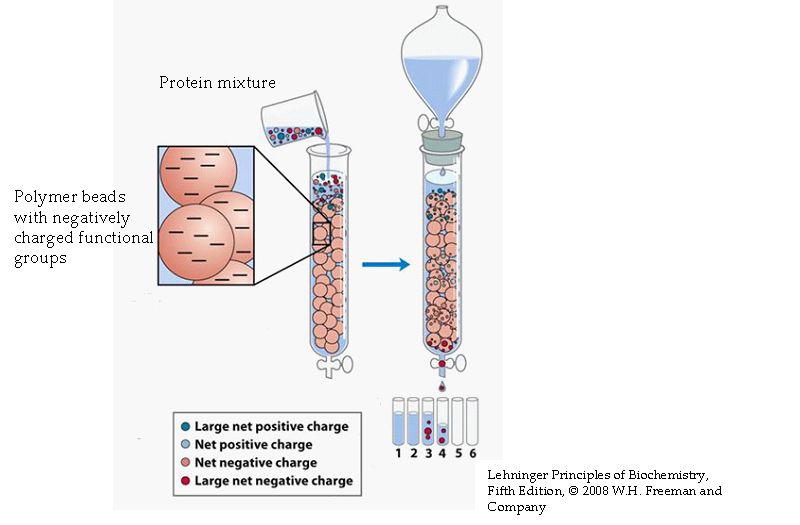
week 6: Solvent extraction & ion exchange chromatography
Ion exchange (IEX) chromatography is a technique that is commonly used in biomolecule purification. It involves the separation of molecules on the basis of their charge.
This technique exploits the interaction between charged molecules in a sample and oppositely charged moieties in the stationery phase of the chromatography matrix. This type of separation is difficult using other techniques as charge is easily manipulated by the pH of buffer used.
Two types of ion exchange separation is possible - cation exchange and anion exchange. In anion exchange the stationary phase is positively charged whilst in cation exchange it is negatively charged.
Principle of Ion Exchange Chromatography
IEX chromatography is used in the separation of charged biomolecules. The crude sample containing charged molecules is used as the liquid phase. When it passes through the chromatographic column, molecules bind to oppositely charged sites in the stationary phase.
The molecules separated on the basis of their charge are eluted using a solution of varying ionic strength. By passing such a solution through the column, highly selective separation of molecules according to their different charges takes place.
The Technique
Key steps in the ion exchange chromatography procedure are listed below:
- An impure protein sample is loaded into the ion exchange chromatography column at a particular pH.
- Charged proteins will bind to the oppositely charged functional groups in the resin
- A salt gradient is used to elute separated proteins. At low salt concentrations, proteins having few charged groups are eluted and at higher salt concentrations, proteins with several charged groups are eluted.
- Unwanted proteins and impurities are removed by washing the column.
A pH gradient can also be applied to elute individual proteins on the basis of their isoelectric point (pI) i.e. the point at which the amino acids in a protein carry neutral charge and hence do not migrate in an electric field. As amino acids are zwitter ionic compounds they contain groups having both positive and negative charges. Based on the pH of the environment, proteins carry a positive, negative, or nil charge. At their isoelectric point, they will not interact with the charged moieties in the column resin and hence are eluted. A decreasing pH gradient can be used to elute proteins using an anion exchange resin and an increasing pH gradient can be used to elute proteins from cation exchange resins. This is because increasing the buffer pH of the mobile phase causes the protein to become less protonated (less positively charged) so it cannot form an ionic interaction with the negatively charged resin, allowing is elution. Conversely, lowering the pH of the mobile phase will cause the molecule to become more protonated (less negatively charged_, allowing its elution.
Resin Selection in Ion Exchange Chromatography
Ion exchange resins have positively or negatively charged functional groups covalently linked to a solid matrix. Matrices are usually made of cellulose, polystyrene, agarose, and polyacrylamide. Some of the factors affecting resin choice are anion or cation exchanger, flow rate, weak or strong ion exchanger, particle size of the resin, and binding capacity. The stability of the protein of interest dictates the selection of an anion or a cation exchanger – either exchanger may be used if the stability is of no concern.
The Applications of Ion Exchange Chromatography
Ion exchange is the most widely used chromatographic method for the separation and purification of charged biomolecules such as polypeptides, proteins, polynucleotides, and nucleic acids. Its widespread applicability, high capacity and simplicity, and its high resolution are the key reasons for its success as a separation method. Ion exchange chromatography is widely used in several industrial applications some of which are as follows:
- Separation and Purification of blood components such as albumin,recombinant growth factors and enzymes.
- Biotechnology - Analytical applications such as quality control and process monitoring
- Food and clinical research - to study wheat varieties and the correlation of proteinuria with different renal diseases.
- Fermentation - Cation exchange resins are used to monitor the fermentation process during ß-galactosidase production.


